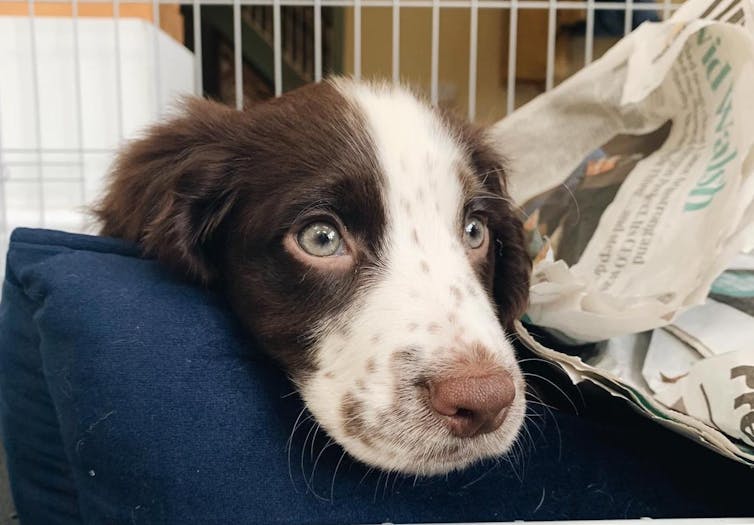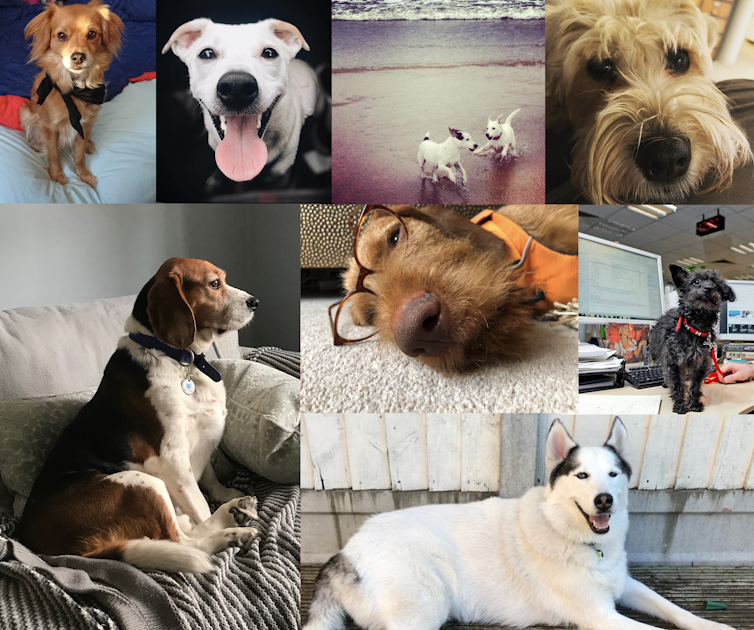Golden Pixels LLC/Shutterstock
Why is our dog Martha so cute? – Sam, aged nine, UK
Dogs are one of the most popular pets in the world – and many owners regard them as an important member of the family unit. Just looking at our dogs can put a smile on our faces. But why is this?
Well, in a nutshell, dogs look cute. With their large, round heads, big eyes that face forwards, soft fur and floppy ears, dogs simply look very appealing to us. They also behave in an endearing manner, with their clumsy movements, nuzzling noses and wagging tails.

Provided by Sam’s mum, CC BY-NC-ND
In many respects, a lot of these characteristics (with the exception of the wagging tails) are very similar to those of a baby – something else that triggers us to feel a bit mushy inside. In fact, some research has even shown that if we look at a picture of a baby and a picture of a puppy, our brains respond in the same way, flooding our body with feelgood chemicals.
Happy chemicals
These chemicals, in turn, help to put us into a good mood and make us feel protective, loving and – importantly – happy. This could explain why so many people search for dog images on social media – it gives them their daily dose of cuteness therapy.
Not only is it normal to find our “fur babies” engaging, it’s also very important that we perceive them that way. If we find something cute, we are much more likely to look after it. Cute things are usually regarded as vulnerable and needy – again, just like babies.
This is important from a survival perspective. And it seems that the younger a dog is, the more likely it is that we will find it attractive.

Curious Kids is a series by The Conversation that gives children the chance to have their questions about the world answered by experts. If you have a question you’d like an expert to answer, send it to [email protected]. We won’t be able to answer every question, but we’ll do our very best.
One particularly neat study demonstrated this by showing a group of people pictures of dogs at different ages and asking them how cute they considered them. Interestingly, the puppies were found to be at their most appealing between eight and ten weeks of age – just when their mums would typically be weaning them and encouraging greater independence. This finding hints at puppies being at their cutest when they are at their most vulnerable.
Our own dogs are the cutest
While dogs in general are considered to be cute, it seems that we are pre-programmed to find our own dogs especially appealing because, very quickly, they become an important part of the family. We give them names, celebrate their birthdays and share their photos like proud parents.

CC BY-NC-ND
The strong bond of attachment that develops between owners and their dogs is not surprising when you consider what goes on chemically when you interact with your pet pooch. A number of studies have shown that looking at, and in particular stroking, our dogs, triggers our brain to release something called oxytocin (sometimes known as the “love” hormone) into the bloodstream.
This so-called “cuddle chemical” helps us feel calmer and allows us to develop a strong bond of affection with our pet. This explains why we find our own dogs so much cuter than those that don’t belong to us.
Although dogs have looked cute for a very long time, they are deliberately being bred by humans to look more and more enchanting. Today’s popular breeds, such as the cockapoo, cavachon and Pomeranian, with their teddy bear appearance, are a far cry from their ancestor, the wolf.
It’s hard to say just how dogs will look in the future, but one thing is for sure: they will all have the cute factor.
When sending in questions to Curious Kids, make sure you include the asker’s first name, age and town or city. You can:
- email [email protected]
- tweet us @ConversationUK with #curiouskids
- DM us on Instagram @theconversationdotcom
![]()
Deborah Wells does not work for, consult, own shares in or receive funding from any company or organisation that would benefit from this article, and has disclosed no relevant affiliations beyond their academic appointment.











